How to heat a greenhouse in winter for free: A greenhouse is a special building made mostly of glass or clear plastic. It is a home for plants. In a greenhouse, plants get the warmth and light they need to grow well, even when the weather outside is too cold or too hot.
In winter, it can get very cold. Plants can die if they get too cold. So, we need to keep the greenhouse warm. When we manage the temperature, we make sure it’s not too cold or too hot for the plants. This way, plants can grow healthy and strong all year long, even greenhouse temperature in winter.
Keeping the right temperature also helps save energy and money. Plus, it’s good for our Earth. With the right temperature, your greenhouse will be a happy place for your plants, even on cold winter days!
How to Heat a Greenhouse in Winter for Free
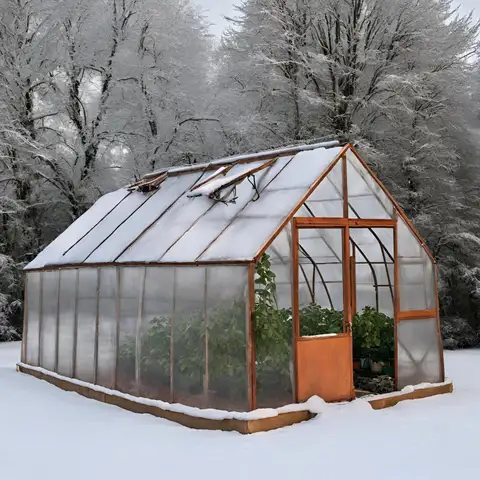
Let’s discover how to utilize solar heat, insulation tricks, and water barrels to do this.
Using Solar Heat:
It is like a big, warm hug for your greenhouse. Actually, in cold winter, the sun can warm up your greenhouse. Here’s how:
Location:
- Set your conservatory greenhouse where it will get lots of sunlight, especially during the warmest part of the day.
Clear Cover:
- Use a clear cover on your greenhouse so lots of sunlight can come in. Keep it clean from dirt and snow.
Insulation Tricks:
It is like providing your conservatory with a warm coat to wear. Here are some tips:
Bubble Wrap:
- Line the interior of your conservatory with bubble wrap. It will assist in maintaining the warmth inside.
Seal the Gaps:
- Look for holes or gaps where cold air can come in and seal them up.
Double Glazing:
- Use two layers of covering to trap more warmth inside.
Water Barrels as Heat Storage:
Water is like a sponge for heat. It can soak up heat and give it off slowly. Here’s how to use it:
Fill and Place:
- Fill big barrels with water and place them in your greenhouse. They will soak up the sun’s warmth during the day.
Spread Them Out:
- Spread the barrels around your greenhouse to share the warmth everywhere.
Paint Them Black:
- Black barrels can soak up more warmth. Paint your barrels black to get more heat from them.
Small greenhouse temperature in winter
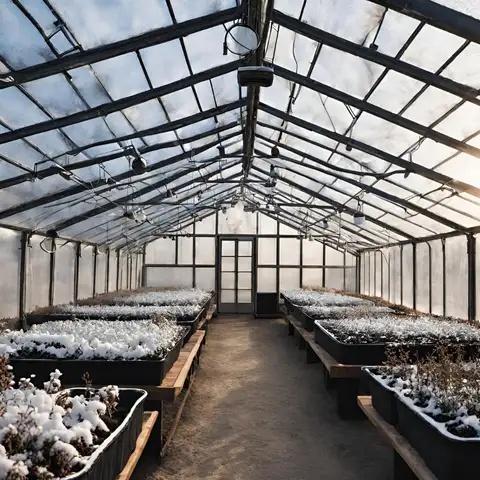
When winter arrives, keeping a small greenhouse warm is hard, but it’s key for your plants. Here’s a look at the challenges, benefits, and tips to help manage the temperature in your small greenhouse during winter.
Challenges and Benefits:
Challenges:
- Losing heat Quickly: Small greenhouses lose heat fast as they need more space to hold the heat in.
- Cost: It can cost a lot to warm the greenhouse, especially if cold air gets in easily.
- Changing Temperatures: The temperature can change a lot, becoming too cold at night.
- Ventilation: It’s tricky to let fresh air in without letting the heat out.
Benefits:
- Growing All Year: With a warm greenhouse, you can grow plants even in cold weather.
- Safe Plants: The greenhouse keeps plants safe from frost, snow, and cold wind.
- Better Growth: Plants grow better in a warm greenhouse during winter.
Tips to Manage Temperature:
Insulation:
- Bubble Wrap: Putting bubble wrap on the inside walls helps keep heat in.
- Seal Gaps: Make sure there are no gaps around the doors or vents where cold air can come in.
Heating Tools:
- Portable Heaters: Small heaters can help keep the greenhouse warm, especially at night.
- Heating Mats: These mats warm the soil and are great for starting seeds or keeping tropical plants happy.
Use Water Jugs:
- Heat Storage: Fill big containers with water. They soak up heat in the day and give it off at night.
Good Airflow:
- Fresh Air: Even in winter, plants need fresh air. Just be sure to keep the warm air in, too.
Check the Temperature:
- Thermometer: Use a thermometer to check if it’s too cold or too hot in the greenhouse.
Block the Wind:
- Windbreaks: Plant bushes or set up fences around your greenhouse to block cold winds.
Catch the Sun:
- Sunlight: Make sure the sun can shine into your greenhouse to give natural warmth.
Greenhouse Temperature Range
Let’s explore the best temperature range for different plants and what things can change the temperature in a greenhouse.
Ideal Temperature Range for Different Types of Plants:
Vegetables:
- Tomatoes, Peppers, and Cucumbers: They like it warm, between 60°F to 90°F in the daytime and above 55°F at night.
- Leafy Greens like Lettuce and Spinach: They are comfy between 45°F to 75°F.
Fruits:
- Citrus Fruits: They love the warmth, between 70°F to 90°F.
- Strawberries: They prefer a cozy 60°F to 80°F.
Herbs:
- Basil, Rosemary, and Oregano: They enjoy it between 50°F to 85°F.
Flowers:
- Most flowers bloom well between 60°F to 75°F.
These temperatures help your plants grow big and strong.
Things That Can Change Greenhouse Temperature:
Sunlight:
- Sunlight warms up your greenhouse. Place it where it gets lots of sun, especially in winter.
Insulation:
- Good insulation keeps the warmth in. Check for gaps or holes and seal them up.
Ventilation:
- Fresh air helps control the temperature. On warm days, it cools down your greenhouse.
Heating Systems:
- If you use heaters, pick good ones as they can change the temperature.
Water Storage:
- Water barrels soak up heat in the day and give it off at night, helping control the temperature.
Outside Temperature:
- Cold winds or hot days outside will affect the temperature inside your greenhouse.
Plant Density:
- More plants can warm up the place as they give off heat.
What Temperature Should a Greenhouse Be at Night?
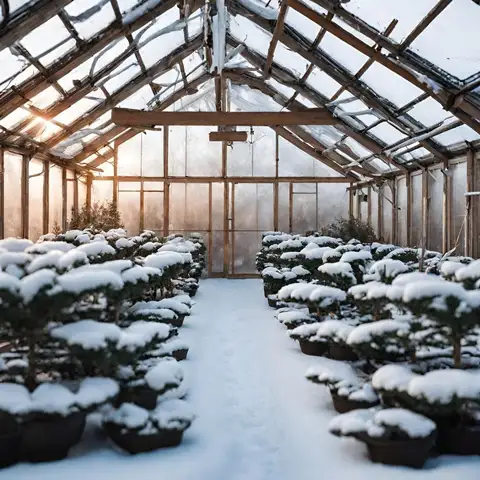
At night, a greenhouse should be between 55°F to 60°F for most plants. But plants like lettuce and kale like it cooler, around 45°F to 50°F.
Ways to Keep Night-time Warm:
- Keep Air In:
- Shut all vents and doors when the sun goes down to keep warm air in.
- Use Warm Curtains:
- Warm curtains or blankets help keep heat in at night.
- Water Barrels:
- Water barrels soak up heat in the day and let it out slowly at night.
- Make It Snug:
- Make sure your greenhouse is snug to keep heat in.
Keeping a Greenhouse Warm at Night
Making It Snug:
Bubble Wrap:
- Put bubble wrap on the inside walls and roof to keep more heat in.
Close Gaps:
- Check for holes or gaps and close them up.
Keep Heat With Stuff:
Stone or Brick:
- Stone or brick things in your greenhouse hold heat and let it out slowly.
Water Containers:
- Water containers hold heat and let it out slowly, too.
Extra Warmth for Cold Nights:
Portable Heater:
- Have a small heater for very cold nights.
Hot Water Bottles:
- Fill hot water bottles and put them around to give extra warmth.
Heating Cables:
- Warm cables in the soil keep plant roots warm, which is good for tropical plants or baby plants.
Greenhouse Heaters
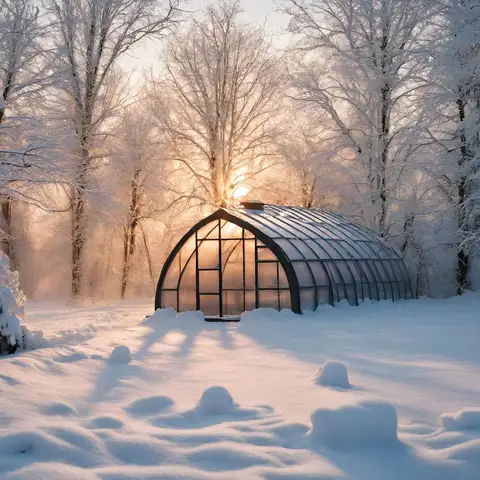
There are different types of heaters you can use, each with its benefits and drawbacks.
Types of Greenhouse Heaters:
Electric Heaters:
- Electric heaters are easy to use. You plug them in and set the temperature you want.
Gas Heaters:
- Gas heaters use propane or natural gas. They can warm up a greenhouse quickly.
Paraffin Heaters:
- Paraffin heaters use liquid fuel. They are portable and don’t need electricity.
Solar Heaters:
- Solar heaters use sunlight to create heat. They are eco-friendly and can save you money in the long run.
Tube Heaters:
- Tube heaters are long, thin heaters that warm the air slowly and evenly.
Heating Mats and Cables:
- These go on the floor or in the soil to keep plants’ roots warm.
Pros and Cons of Using Heaters:
Pros:
- Extended Growing Season: Heaters let you grow plants in your greenhouse all year round.
- Protection from Cold: Heaters protect your plants from frost and cold temperatures.
- Better Plant Growth: Warmth helps plants grow better.
Cons:
- Cost: Buying and running heaters can cost money.
- Setup: Some heaters need a gas line or other setup.
- Safety: Heaters can be a fire risk if not used carefully.
Off-grid Greenhouse Heating Techniques
Keeping a Greenhouse Warm Without Electricity:
Solar Heaters:
- These heaters use sunlight to make heat. They are good for the Earth and save money over time.
Water Barrels:
- Fill big barrels with water. They soak up heat in the day and give it off at night.
Compost Heating:
- A pile of compost makes heat as it breaks down. Put a compost pile in or near your greenhouse for natural heat.
Thermal Mass:
- Things like rocks, bricks, or ceramic containers hold and give off heat.
Insulation:
- Cover the walls and roof of your greenhouse with bubble wrap or other materials to keep heat in.
Windbreaks:
- Plant bushes or put up fences around your greenhouse to block cold winds and keep it warmer.
Other Ways to Make Heat:
Biomass Heaters:
- These heaters use things like wood chips or pellets to make heat.
Rocket Mass Heaters:
- These heaters burn wood efficiently to make a lot of heat with a little wood.
Geothermal Heating:
- These systems use the Earth’s steady temperature to heat the greenhouse.
Ideal Greenhouse Temperature in Celsius
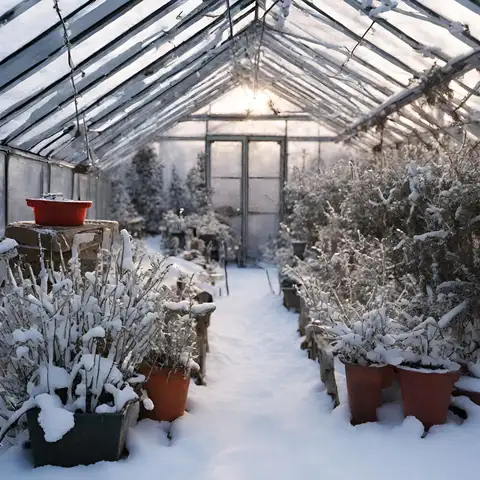
Differentiating Between Day and Night Temperatures:
Day and Night Temperatures:
- Day temperatures should be between 18°C to 29°C to help plants grow.
- Night temperatures can be cooler, around 10°C to 18°C.
Right Temperatures for Common Greenhouse Plants:
Tomatoes and Peppers:
- Day: 21°C to 29°C, Night: At least 12°C.
Leafy Greens:
- Day: 15°C to 22°C, Night: At least 7°C.
Herbs:
- Day: 18°C to 24°C, Night: At least 10°C
Winter Greenhouse Fundamentals
Do Greenhouses Keep Plants Warm in Winter?
Yes, greenhouses help keep plants warm in winter. They catch sunlight and trap the heat inside, making it warmer than outside.
Why Heat a Greenhouse in Winter?
Heating a greenhouse in winter is important. It helps keep plants warm and safe from cold weather. It lets you grow plants all year round.
Tips for Winter Greenhouse Management
How to Keep a Greenhouse Warm During Winter:
Catch the Sun:
- Make sure your greenhouse gets a lot of sun during the day.
Seal It Up:
- Close any gaps to keep the cold air out.
Insulate:
- Use bubble wrap to keep more heat in.
Use Water Barrels:
- Fill barrels with water to store heat during the day and let it out at night.
Warm Curtains:
- Use warm curtains at night to keep heat in.
Heating a Greenhouse Without Electricity:
- Solar Heater:
- Use a solar heater to catch and store heat from the sun.
Compost Pile:
- A compost pile in or near the greenhouse can give off heat.
Water Barrels:
- Water barrels soak up heat in the day and let it out at night.
Thermal Mass:
- Use stones, bricks, or water containers to store and let out heat.
Insulate:
- Keep the greenhouse snug to hold more heat in.
Cost-effective Heating Solutions
What is the Cheapest Way to Heat a Greenhouse?
The most budget-friendly way to heat a greenhouse is by using natural sunlight, insulation, and thermal mass.
Budget-friendly Insulation and Heating Alternatives:
Bubble Wrap:
- Use bubble wrap to insulate the walls and roof of your greenhouse.
Water Barrels:
- Fill barrels with water to store and release heat.
Compost Pile:
- A compost pile inside or near your greenhouse can generate heat.
Understanding Overheating
Identifying Signs of Overheating:
Wilting Plants:
- Plants may wilt if it gets too hot.
Yellow or Brown Leaves:
- Leaves might turn yellow or brown.
Slow Growth:
- Plants may grow slowly or stop growing.
How Warm is Too Warm in a Greenhouse?
It depends on the plants, but generally, temperatures above 90°F can be too warm for many plants.
Can a Greenhouse Get Too Hot?
Yes, greenhouses can get too hot if not well-ventilated, especially during sunny days.
How to Prevent Overheating and Ensure Ventilation:
Roof Vents:
- Install roof vents to let hot air out.
Shade Cloth:
- Use a shade cloth to block some sun on very hot days.
Thermal Curtains:
- Use thermal curtains to control temperature.
Conclusion
Managing greenhouse temperatures in winter is crucial for your plants’ health.
Embrace sustainable practices to enjoy a fruitful greenhouse gardening experience all year round.
FAQs
Do greenhouses keep plants warm in winter?
Yes, greenhouses help keep plants warm in winter. They catch the sun’s warmth, which helps plants grow even when it’s cold outside.
Do you need to heat a greenhouse in the winter?
It depends on the plants you have and how cold it gets. Some plants need extra warmth, so you might need to heat your greenhouse.
How do I keep my greenhouse warm in the winter?
You can keep it warm by using heaters, covering your greenhouse with insulating materials, using water barrels to hold warmth, or using solar heaters.
How can I heat my greenhouse in winter without electricity?
You can use solar heaters and water barrels or make a compost pile inside. These things can create warmth without needing electricity.
Can a greenhouse get too hot?
Yes, a greenhouse can get too hot if it catches too much sun. It’s good to have vents or shades to cool it down.
What is the ideal temperature for a greenhouse in Celsius?
Different plants like different temperatures. But many plants like it when it’s between 18°C to 29°C during the day and 10°C to 18°C at night.
What is the cheapest way to heat a greenhouse?
Using water barrels or making a compost pile inside can be cheap ways to warm your greenhouse.
How warm is too warm in a greenhouse?
If it gets hotter than 29°C (85°F), it might be too warm for many plants. It’s important to keep your greenhouse cool enough.
How can I monitor the temperature in my greenhouse?
You can use a thermometer to check the temperature. Some digital tools can even tell you the temperature on your phone.
How often should I check the temperature in my greenhouse?
Checking it once a day is good. But in very hot or cold weather, it’s better to check more often.













